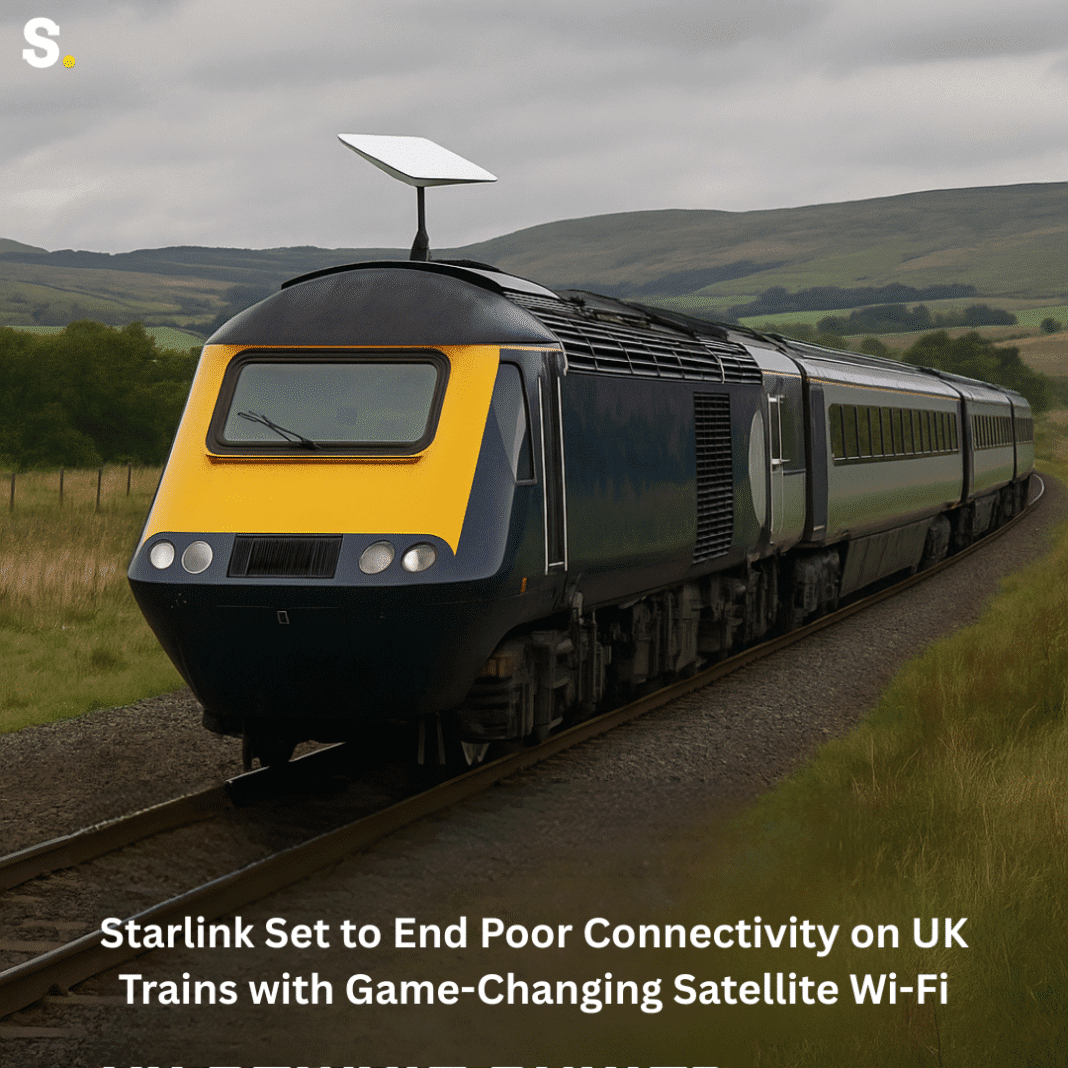Something big is happening on UK train journeys—and it’s not just new seats or faster engines. It’s about internet. For years, train passengers in the UK have struggled with poor Wi-Fi and weak mobile signals. Watching a video, making a video call, or even just sending a message often felt impossible while traveling through the countryside or remote areas.
A Bold Shift: High-Speed Satellite Wi-Fi Hits UK Rails
But now, that could change.
Elon Musk’s Starlink, the satellite internet service from SpaceX, is being tested on several train routes across the UK. Starlink uses thousands of satellites that orbit close to Earth, known as low-Earth orbit (LEO) satellites. These satellites send internet signals straight down to special receivers on moving trains.
Unlike mobile towers, which can’t reach every part of the country—especially remote areas or places with lots of hills and tunnels—Starlink beams its signals from space. This makes it possible for passengers to stay connected even in places where regular networks fail.
Train routes in the Scottish Highlands are already trying out this new technology. Routes from Inverness to towns like Wick, Kyle of Lochalsh, and Aberdeen are seeing high-speed satellite Wi-Fi in action. Passengers on these trains can now enjoy smooth streaming, clear phone calls, and reliable internet connections where none existed before.
And it’s not just Scotland. Wales is getting ready to test Starlink Wi-Fi too. Transport for Wales plans to bring the technology to routes between Cardiff, Holyhead, and Manchester. That means more people will soon experience the benefits of strong Wi-Fi while riding the rails.
The Sun Is Striking Back—Starlink Satellites Are Falling Victim to Surging Solar Storms
Even private rail companies are joining in. FirstGroup’s Lumo and Hull Trains services are exploring Starlink as a way to upgrade the passenger experience. They want to offer better onboard internet and stay competitive.
Why This Matters: From Dead Zones to Digital Highways
For a long time, train Wi-Fi in the UK was known for being unreliable and slow. Passengers had to deal with dropped connections, long loading times, and apps that stopped working halfway through a journey. One reason for this was that mobile signals don’t work well in many parts of the country. Rural areas, tunnels, and coastlines often have no coverage at all.
Starlink changes that by avoiding ground-based towers completely. It uses over 7,000 satellites that orbit around 550 km above Earth. These satellites send internet signals to a dish mounted on the train’s roof. As the train moves, the dish tracks the satellites and keeps the connection strong.
This setup brings powerful and stable Wi-Fi to places that were once out of reach. On long trips, passengers can now stream movies, make video calls, and use apps without interruption.
The trials in Scotland have already shown how useful this can be. People traveling through the Highlands, where phone signals often disappear, have reported much better internet access with Starlink. This is a big win for both passengers and train companies.
The system can be installed quickly and doesn’t need new towers or underground cables. This makes it easier and cheaper to roll out in hard-to-reach areas. And because Starlink’s system supports real-time GPS tracking, it also helps train operators improve safety and service.
FCC Launches Landmark Review of 1990s Satellite Rules to Boost Starlink Speeds
Train companies also benefit in other ways. They can use the same Wi-Fi network for onboard operations, like sending updates to the driver, monitoring equipment, or managing staff communications.
National Support and Expanding Trials
The UK government is backing the use of satellite technology in rail travel. The Department for Transport has said that trials like these are important for modernizing the country’s rail system. The aim is to create smart trains that meet the needs of today’s tech-savvy passengers.
Other companies are also interested in how Starlink can help. BT, one of the UK’s largest telecom providers, is working with Starlink to offer satellite dishes for home internet in rural areas. This shows that the technology is being seen as part of a bigger plan to improve internet access across the UK.
Meanwhile, other rail projects are also helping to improve connectivity. In London, the train company LNER has installed new antennas in tunnels near King’s Cross station. These antennas boost mobile signal from networks like O2 and Three, making it easier for passengers to stay connected even underground.
This mix of satellite and ground-based improvements is creating a stronger, more reliable internet system across the whole country.
Passengers are already noticing the change. People who used to dread long train rides because of poor internet now have more ways to stay online. Business travelers can work during their commute, families can stream movies, and students can study without losing connection.
Starlink’s satellite Wi-Fi is not just a small upgrade—it’s a new way of thinking about travel. Every route that adds this service brings more freedom and comfort to the journey.
With more trials underway and interest growing among rail companies, satellite internet is quickly becoming a key part of the UK’s railway future. Whether you’re riding through the Highlands or heading to Manchester, you might soon be able to browse, stream, and call with no interruptions—all thanks to satellites flying overhead.




